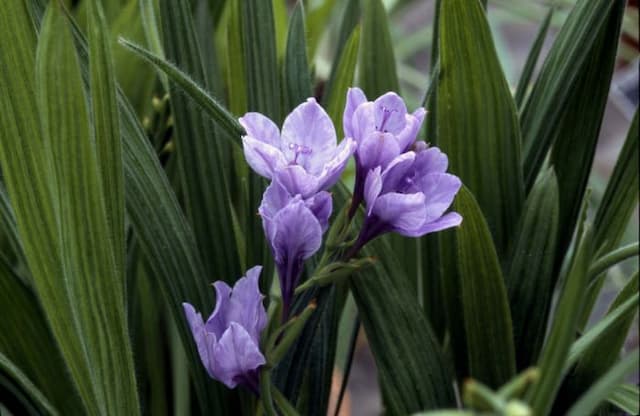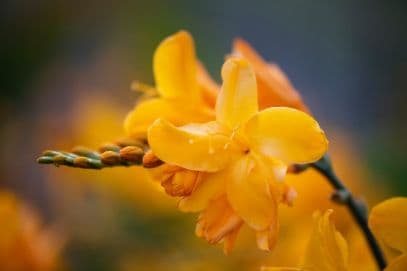Variegated Japanese Iris Iris laevigata 'Variegata' (v)

ABOUT
The Iris laevigata 'Variegata', commonly known as Variegated Japanese Iris, is a distinctive and elegant plant known for its striking foliage and beautiful flowers. The leaves are sword-shaped with a unique variegation. Each leaf blade features bold cream-yellow stripes that run longitudinally along the green foliage, creating a vivid contrast and an eye-catching pattern. This variegation can add a splash of light to any garden, even when the plant is not in bloom. The flowers of the Variegated Japanese Iris are equally impressive. They typically blossom in late spring to early summer, displaying large, flat or slightly ruffled blooms that sit atop sturdy, upright stems. The petals are usually a rich shade of deep blue or purple, sometimes with a lighter or white halo around the yellow or white center. The flowers can also have a slight iridescence, which contributes to their striking appearance. The overall form of the Variegated Japanese Iris is clump-forming, with the leaves creating a lush, grass-like effect. Even after the blooming period is over, the variegated foliage continues to provide a decorative element in the garden. This plant is often used in water gardens or as a border plant, where its decorative leaves and flowers can be admired up close.
About this plant
 Names
NamesSynonyms
Variegated Japanese Iris, Variegated Water Iris, Variegated Rabbit-ear Iris.
Common names
Iris laevigata 'Variegata'.
 Toxicity
ToxicityTo humans
Iris laevigata 'Variegata', commonly known as Japanese water iris, is not generally considered highly toxic to humans. However, as with many plants, if ingested, parts of the Japanese water iris may cause discomfort or adverse reactions. The rhizomes and bulbs contain irritants that can cause stomach pain, nausea, vomiting, and diarrhea if swallowed. Handling the plant may also cause skin irritation in some individuals due to its naturally occurring compounds.
To pets
Japanese water iris, the common name for Iris laevigata 'Variegata', can be toxic to pets if ingested, particularly the rhizomes and bulbs. Cats and dogs may experience symptoms such as drooling, vomiting, diarrhea, and abdominal pain. It is advised to prevent pets from ingesting this plant to avoid the possibility of gastrointestinal upset or more severe symptoms that can occur with the consumption of larger amounts.
 Characteristics
CharacteristicsLife cycle
Perennials
Foliage type
Deciduous
Color of leaves
Variegated
Flower color
Blue
Height
2 feet (60 cm)
Spread
2 feet (60 cm)
Plant type
Bulb
Hardiness zones
4
Native area
Japan
Benefits
 General Benefits
General Benefits- Aesthetic Appeal: Iris laevigata 'Variegata', commonly known as Variegated Water Iris, adds visual interest to any garden with its striking foliage that is striped with cream and green colors.
- Habitat Enrichment: The Variegated Water Iris provides a suitable habitat for aquatic wildlife, offering cover and breeding grounds for insects and amphibians.
- Erosion Control: The root system of the Variegated Water Iris helps to stabilize pond banks and waterside areas, reducing the erosion caused by water movement.
- Water Quality Improvement: The Variegated Water Iris can absorb excess nutrients in ponds, helping to reduce algae growth and maintain clean and clear water.
- Pollinator Attraction: The flowers of the Variegated Water Iris attract pollinating insects, which are essential for the pollination of many plants and the overall health of the ecosystem.
- Low Maintenance: The Variegated Water Iris is known for being a low-maintenance plant that requires minimal care once established, making it suitable for gardeners of all skill levels.
- Seasonal Interest: This iris species offers seasonal interest with its decorative foliage in spring and summer, and intriguing seed pods in autumn and winter.
- Water Garden Feature: It is an ideal plant for water gardens or ponds, helping to create a naturalistic aquatic environment.
 Medical Properties
Medical Properties- This plant is not used for medical purposes.
 Air-purifying Qualities
Air-purifying QualitiesThis plant is not specifically known for air purifying qualities.
 Other Uses
Other Uses- The variegated leaves of the Japanese iris can be used in floral arrangements to add a unique pattern and texture contrast to bouquets.
- The sturdy leaves can be woven into small baskets or mats, utilizing traditional Japanese weaving techniques.
- Japanese iris plants can be incorporated into water garden designs, providing aesthetic beauty with their foliage even when not in bloom.
- Dried seed pods from Japanese iris can be used in crafts and as natural decorations in dry floral arrangements.
- Japanese iris can act as a natural dye source, where the flowers provide subtle color for fabrics or paper.
- Pressed leaves and flowers of the Japanese iris can be used to create botanical art pieces or included in herbarium collections.
- Photographers and painters may use the beautiful variegated patterns of the leaves as subjects for artistic studies and compositions.
- The plant may be used as an educational tool to demonstrate variegation and other botanical concepts in horticulture classes.
- Gardeners can use Japanese iris plants to create habitat for wildlife, attracting bees, butterflies, and birds with their flowers.
- The root systems of Japanese iris can help stabilize pond banks and prevent erosion in a natural, visually appealing way.
Interesting Facts
 Feng Shui
Feng ShuiThe Japanese Water Iris is not used in Feng Shui practice.
 Zodiac Sign Compitability
Zodiac Sign CompitabilityThe Japanese Water Iris is not used in astrology practice.
 Plant Symbolism
Plant Symbolism- Faith: The iris commonly symbolizes faith, with different types and colors representing various aspects of faith.
- Wisdom: Historically, irises are seen as a symbol of wisdom and valued for their association with intelligence and knowledge.
- Hope: The iris can also represent hope, often depicted in art and literature as a sign of optimism for the future.
- Courage: In some cultural contexts, the iris is a emblematic of courage, possibly due to its bold shapes and colors.
- Purity: The pure white petals of some iris species, particularly in Japan where Iris laevigata is native, are seen as a sign of purity and innocence.
- Royalty: The lavish appearance of the iris has led it to be associated with royalty and regal bearing.
 Water
WaterVariegated Water Iris should be kept constantly wet as it thrives in boggy conditions or at the water's edge. Water generously to maintain consistent moisture, ideally giving the plant about one to two inches of water per week, depending on the weather conditions. During periods of extreme heat, additional watering may be necessary to prevent the soil from drying out. It's best to apply water directly to the soil rather than overhead to minimize the risk of leaf diseases. These plants do not tolerate drought, so ensure they have ample water, especially during their growing season in spring and early summer.
 Light
LightVariegated Water Iris flourishes best in full sun to partial shade. An ideal spot would receive at least six hours of direct sunlight a day but could be protected from the intense heat of the late afternoon sun. If placed in too much shade, the plant may not bloom as vigorously and could become more susceptible to disease.
 Temperature
TemperatureVariegated Water Iris prefers moderate temperatures and can tolerate a range from about 70°F to 85°F for optimal growth. It can survive minimum temperatures down to about 30°F but should be protected from prolonged freezes. The rhizomes can withstand colder winter temperatures if they are submerged in water or adequately mulched.
 Pruning
PruningPrune the Variegated Water Iris to remove spent blooms and any yellowing or dead foliage to maintain plant health and appearance. The best time for pruning is post-flowering or in late autumn before winter dormancy. Regular pruning helps to encourage airflow around the plant, which can reduce the risk of disease, and promotes vigorous growth for the following season.
 Cleaning
CleaningAs needed
 Soil
SoilFor the Variegated Japanese Iris, the best soil mix should be acidic to neutral, with a pH ranging from 5.5 to 7. An ideal mix includes loamy soil with organic matter, well-draining but consistently moist, like a peat-based mixture.
 Repotting
RepottingThe Variegated Japanese Iris should be repotted every 2-3 years to refresh the soil and accommodate its spreading habit, with spring being the best time for repotting.
 Humidity & Misting
Humidity & MistingVariegated Japanese Iris thrives in high humidity conditions similar to its native wetland habitat; maintaining high humidity is beneficial for its growth.
 Suitable locations
Suitable locationsIndoor
Keep in bright light, moist soil, high humidity.
Outdoor
Plant in wet soils, full sun to part shade.
Hardiness zone
4-9 USDA
 Life cycle
Life cycleIris laevigata 'Variegata', commonly known as Variegated Water Iris, starts its life cycle when seeds are dispersed into suitable wet soil or when rhizomes are divided and replanted. Germination occurs with adequate moisture and temperature, leading to the emergence of seedlings which then develop into juvenile plants. Once established, the rhizomes spread, and the plant enters a vegetative growth phase, producing variegated leaves that rise erect or slightly curved. Flowering occurs in late spring to early summer, when showy blue or violet flowers appear, attracting pollinators for sexual reproduction. After pollination, the flowers develop into seed capsules which eventually burst, releasing seeds into the water to perpetuate the cycle. During the winter, the foliage may die back, especially in colder climates, while the rhizomes remain dormant underwater until the conditions improve for the next growing season.
 Propogation
PropogationPropogation time
Early spring
Propogation: The most popular method of propagation for the Japanese Water Iris, which is Iris laevigata 'Variegata', typically takes place through division of the rhizomes. This process is ideally done after the flowering period in late summer to early fall. Gardeners should carefully dig up the iris clumps and gently separate the rhizomes, ensuring each division has at least one healthy fan of leaves. It's important to trim the leaves to about one-third of their original height, which is approximately 4 to 6 inches (about 10 to 15 centimeters) to reduce transpiration and stress on the plant. The divisions can then be replanted in a waterlogged bed or a shallow part of a pond with the top of the rhizome just at or slightly below the soil surface, spacing them about 18 inches (45 centimeters) apart to allow room for growth.









